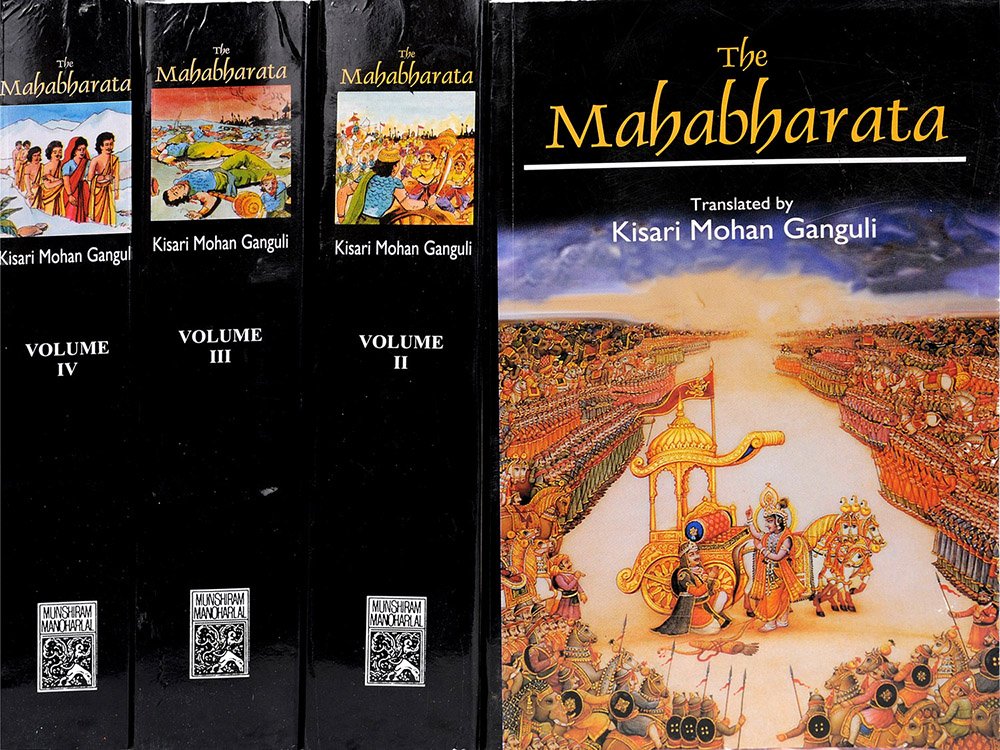Mahabharata (English)
by Kisari Mohan Ganguli | 2,566,952 words | ISBN-10: 8121505933
The English translation of the Mahabharata is a large text describing ancient India. It is authored by Krishna-Dwaipayana Vyasa and contains the records of ancient humans. Also, it documents the fate of the Kauravas and the Pandavas family. Another part of the large contents, deal with many philosophical dialogues such as the goals of life. Book...
Section XVI
Sanjaya said,—
"When the night had passed away, loud became the noise made by the kings, all exclaiming, Array! Array! 'With the blare of conches and the sound of drums that resembled leonine roars, O Bharata, with the neigh of steeds, and the clatter of car-wheels, with the noise of obstreperous elephants and the shouts, clapping of arm-pits, and cries of roaring combatants, the din caused everywhere was very great. The large armies of the Kurus and the Pandavas, O king, rising at sunrise, completed all their arrangements. Then when the Sun rose, the fierce weapons of attack and defence and the coats of mail of both your sons and the Pandavas, and the large and splendid armies of both sides, became fully visible. There elephants and cars, adorned with gold, looked resplendent like clouds mingled with lightning. The ranks of cars, standing in profusion, looked like cities.
And your father, stationed there, shone brilliantly, like the full moon. And the warriors armed with bows and swords and scimitars and maces, javelins and lances and bright weapons of diverse kinds, took up their positions in their (respective) ranks. And resplendent standards were seen, set up by thousands, of diverse forms, belonging to both ourselves and the foe. And made of gold and decked with gems and blazing like fire, those banners in thousands endued with great effulgence, looked beautiful like heroic combatants cased in mail gazed at those standards, longing for battle.[1] And many foremost of men, with eyes large as those of bulls endued with quivers, and with hands cased in leathern fences, stood at the heads of their divisions, with their bright weapons upraised.
And Suvala’s son Sakuni, and Salya, Jayadratha and the two princes of Avanti named Vinda and Anuvinda, and the Kekaya brothers, and Sudakshina the ruler of the Kamvojas and Srutayudha the ruler of the Kalingas, and king Jayatsena, and Vrihadvala the ruler of the Kosalas, and Kritavarman of Satwata’s race,—these ten tigers among men, endued with great bravery and possessing arms that looked like maces,—these performers of sacrifices with plentiful gifts (to Brahmanas), stood each at the head of an Akshauhini of troops. These and many other kings and princes, mighty car-warriors conversant with policy, obedient to the commands of Duryodhana, all cased in mail, were seen stationed in their respective divisions. All of them, cased in black deer-skins, endued with great strength, accomplished in battle, and cheerfully prepared, for Duryodhana’s sake, to ascend to the region of Brahma,[2] stood there commanding ten efficient Akshauhinis.
The eleventh great division of the Kauravas, consisting of the Dhartarashtra troops, stood in advance of the whole army. There in the van of that division was Santanu’s son. With his white head-gear, white umbrella, and white mail, O monarch, we beheld Bhishma of unfailing prowess look like the risen moon. His standard bearing the device of a palmyra of gold himself stationed on a car made of silver, both the Kurus and the Pandavas beheld that hero looking like the moon encircled by white clouds. The great bowmen amongst the Srinjayas headed by Dhrishtadyumna, (beholding Bhishma) looked like little animals when they would behold a mighty yawning lion. Indeed, all the combatants headed by Dhrishtadyumna repeatedly trembled in fear. These, O king, were the eleven splendid divisions of your army. So also the seven divisions belonging to the Pandavas were protected by foremost of men. Indeed, the two armies facing each other looked like two oceans at the end of the Yuga agitated by fierce Makaras, and abounding with huge crocodiles. Never before, O king, did we see or hear of two such armies encountering each other like these of the Kauravas.'
Footnotes and references:
Conclusion:
This concludes Section XVI of Book 6 (Bhishma Parva) of the Mahabharata, of which an English translation is presented on this page. This book is famous as one of the Itihasa, similair in content to the eighteen Puranas. Book 6 is one of the eighteen books comprising roughly 100,000 Sanskrit metrical verses.
FAQ (frequently asked questions):
Which keywords occur in Section XVI of Book 6 of the Mahabharata?
The most relevant definitions are: Pandavas, Kurus, Dhrishtadyumna, Bhishma, Kauravas, Duryodhana; since these occur the most in Book 6, Section XVI. There are a total of 30 unique keywords found in this section mentioned 39 times.
What is the name of the Parva containing Section XVI of Book 6?
Section XVI is part of the Bhagavat-Gita Parva which itself is a sub-section of Book 6 (Bhishma Parva). The Bhagavat-Gita Parva contains a total of 112 sections while Book 6 contains a total of 3 such Parvas.
Can I buy a print edition of Section XVI as contained in Book 6?
Yes! The print edition of the Mahabharata contains the English translation of Section XVI of Book 6 and can be bought on the main page. The author is Kisari Mohan Ganguli and the latest edition (including Section XVI) is from 2012.
